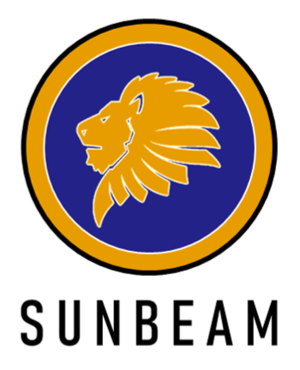Sunbeam
| Template:GBR Sunbeam | |
 Sunbeam Car Company | |
| Details | |
|---|---|
| Founded | 1905 (original company) 2022 (modern company) |
| Owners | McEwan Automotive |
| Based | Dartford, Kent, United Kingdom |
| Nationality | Template:GBR British |
| Notable Figures | |
| Template:GBR Neil McEwan | |
The Sunbeam Car Company, generally known simply as Sunbeam, is a historic British automotive manufacturer founded in 1905 by John Marston, and revived in 2022 by ex-Formula One driver Neil McEwan and his company McEwan Automotive. Sunbeam has had a variety of owners throughout its history, including Marston, Talbot-Darracq, Rootes, Chrysler Europe, PSA Group (as a dormant marque), and since 2022, McEwan Automotive.
History
Sunbeam has a long history in motorsports, dating back to some of the earliest Grand Prix racing, when their roster included star drivers Henry Segrave and Albert Divo, the latter of whom famously won the 1923 Belgian Grand Prix. At the same time, Irish driver Kenelm Lee Guinness used Sunbeam cars fitted with aero engines to set several Land Speed Records at the Brooklands racing circuit. However, these ventures proved to be very expensive. Having accumulated large debts to go racing, the Sunbeam company was sold to the Rootes Group.
Rootes Group pioneered the practice of "badge engineering", which reduced costs and increased profit margins. This also allowed Sunbeam to return to motorsport, competing in sportscar events with some success using the Sunbeam Alpine.
The Rootes Group's sale to Chrysler Europe saw a shift in focus from producing high-quality cars to cheaper, mass-produced vehicles. Ultimately, Chrysler ceased using the Sunbeam marque, and it became dormant for four decades.
In 2021, McEwan Automotive purchased the marque, and announced ambitious plans to begin production of high-quality Sunbeam cars again. Ongoing production of the McEwan MA7 "superlight" car was directed so that post-purchase units would be badged as "Sunbeam MA7", and the following year McEwan announced the construction of the Sunbeam MA8 GTC car to enter the popular sector of GT racing series around the world. Sunbeam also became the title sponsor of the brand new Sunbeam McEwan AMG F1 Team, although the official constructor remained "McEwan-Mercedes".
Selected Models
| Car | Year(s) | Description | Notes |
|---|---|---|---|
| Sunbeam 12 | 1902-1914 | Originally named for its 12 horsepower engine, the Sunbeam 12 was the company's first passenger motor car. | Additional models from this period included the 14, 16, 18, 20, 25 and 30. |
| Sunbeam 350HP | 1920 | Designed by Louis Coatalen around an 18.3 litre V12 aero engine, this car was specifically designed for Land Speed Record attempts. | Kenelm Lee Guinness used the car to set the Land Speed Record at Brooklands in May 1922. |
| Sunbeam 23 | 1923 | Sunbeam's most famous Grand Prix car; this car won the 1923 Belgian Grand Prix for Albert Divo. | Sunbeam competed in Grand Prix racing from 1921 to 1927, with these cars also entered into British races at Brooklands and notable hillclimbs. |
| Sunbeam 3-Litre | 1925-1930 | Built to rival the success of the Bentley 3-Litre which won the 1924 24 Hours of Le Mans, and finished in second place in 1925. | The better-funded Bentley team would ultimately continue to dominate Le Mans for the rest of the decade. |
| Sunbeam Slug | 1927 | The "Slug" (officially Sunbeam 1000HP) had two 22.4-litre aero engines, one mounted in front of the driver and one behind. It was the first car ever to travel at 200 mph. Henry Segrave set the Land Speed Record at Daytona Beach. | The car also had to be fitted with special tyres which were rated to be safe at 200 mph speeds for up to three minutes. |
| Sunbeam Talbot Tem | 1938-1948 | The first new model after Rootes Group took over Sunbeam, this was a "compact executive car". | Approximately 11,000 units were produced across all body styles. |
| Sunbeam Talbot 90 | 1948-1957 | The successor to the Ten, this car was sold as the Sunbeam Talbot 90 until 1954, then later as the Sunbeam Mark III. | Approximately 22,500 units were produced; this also became a popular rally car. |
| Sunbeam Alpine | 1953-1975 | The first major Sunbeam sportscar since the 3-Litre, this car competed with some success at major races. | At least 70,000 units were produced. |
| Sunbeam Rapier | 1954-1976 | A two-door coupé, this car came to replace the Mark III in its sector of the market. | Over 100,000 units were produced including both "Series" and "Fastback" versions of the model. |
| Sunbeam Tiger | 1964-1967 | A front-engine, rear wheel drive sportscar, this car was discontinued after the Chrysler purchase. | Named after a 1920s Land Speed Record car; approximately 7,000 units produced. |
| Chrysler Sunbeam | 1977-1981 | A nimble hatchback that found success badged as a "Talbot Sunbeam Lotus" rally car. | Was renamed "Talbot Sunbeam" after the PSA Group purchase of Chrysler Europe. Approximately 200,000 units were produced. |
| Sunbeam MA7 "Superlight" |
2021-present | Originally sold as the McEwan MA7, this car was sold as the Sunbeam MA7 after the McEwan Automotive revival of the Sunbeam name. | In keeping with the tradition of Sunbeam cars receiving proper names, this one became known as the "Superlight". |
| Sunbeam MA8 GTC "Divo" |
2022-present | The Sunbeam MA8 was built to GTC racing, which mandated at least 20 units be made in a 24-month period following homologation. | This car became known as the "Divo", after Sunbeam's Grand Prix winning driver. |